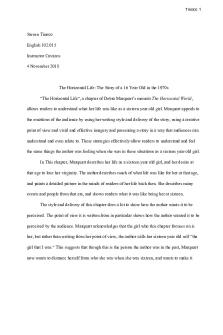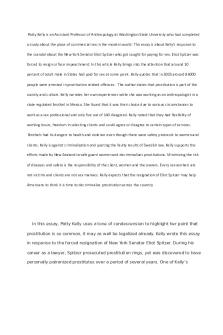Textual Rhetorical Analysis PDF

| Title | Textual Rhetorical Analysis |
|---|---|
| Author | Steven Tinoco |
| Course | Composition II: Reasoning and Research |
| Institution | Central Washington University |
| Pages | 3 |
| File Size | 64.2 KB |
| File Type | |
| Total Downloads | 42 |
| Total Views | 175 |
Summary
Textual rhetorical analysis essay, Pedro Cavazos English 102 Fall 2018...
Description
Tinoco 1
Steven Tinoco English 102.015 Instructor Cavazos 4 November 2018
The Horizontal Life: The Story of a 16 Year Old in the 1970s “The Horizontal Life”, a chapter of Debra Marquart’s memoir The Horizontal World , allows readers to understand what her life was like as a sixteen year old girl. Marquart appeals to the emotions of the audience by using her writing style and delivery of the story, using a creative point of view and vivid and effective imagery and presenting a story in a way that audiences can understand and even relate to. These strategies effectively allow readers to understand and feel the same things the author was feeling when she was in these situations as a sixteen year old girl. In This chapter, Marquart describes her life as a sixteen year old girl, and her desire at that age to lose her virginity. The author describes much of what life was like for her at that age, and paints a detailed picture in the minds of readers of her life back then. She describes many events and people from that era, and shows readers what it was like being her at sixteen. The style and delivery of this chapter does a lot to show how the author wants it to be perceived. The point of view it is written from in particular shows how the author wanted it to be perceived by the audience. Marquart acknowledges that the girl who this chapter focuses on is her, but rather than writing from her point of view, the author calls her sixteen year old self “the girl that I was.” This suggests that though this is the person the author was in the past, Marquart now wants to distance herself from who she was when she was sixteen, and wants to make it
Tinoco 2
known that though this girl was her, she now doesn’t see her as the same person anymore, and, rather, sees her as someone she used to be. Another technique used by the author to help the audience feel more connected to the text is her imagery in her descriptions of her life as a sixteen year old. Marquart provides very detailed descriptions of her life, and through this the audience can better picture the scenes being described by the author. The author is also very descriptive of her emotions, allowing the audience to feel the things she was feeling while writing this chapter and experiencing it firsthand. A potential weakness of this chapter is its age. Though the book it is in was released in 2007, Marquart was writing about when she was sixteen in the early 1970s, and many people may find it hard to relate to this due to its age. Sixteen year olds today may have a hard time relating to this passage because being a sixteen year old in the time this chapter is set was very different from being a sixteen year old today. Though this may be a weakness of this chapter, people still will likely find other ways this piece resonates with them, and some people who grew up around the same time as Marquart may also read this book and find this very relatable. In this chapter, Debra Marquart offers a glimpse into the world of herself as a sixteen year old girl. Marquart helps us see the perspective of her sixteen year old self through her creative use of point of view and imagery. Though none of us can go back and live as a sixteen year old in the 1970s, the chapter of Marquart’s story offers a glimpse into what life might have been like for us back then.
Tinoco 3
“The Horizontal Life.” The Horizontal World: Growing Up Wild in the Middle of Nowhere, by Debra K. Marquart, Counterpoint, 2007, pp. 97–118....
Similar Free PDFs

Textual Rhetorical Analysis
- 3 Pages

Textual Analysis
- 3 Pages

Rhetorical Analysis
- 5 Pages

Textual Analysis
- 2 Pages

Rhetorical analysis
- 2 Pages

Textual Analysis - Podcast
- 3 Pages

Textual Analysis Exercise
- 3 Pages

Perez Hilton Textual Analysis
- 16 Pages

Textual Analysis Outline
- 4 Pages

The Crito - Textual Analysis
- 5 Pages

Puppy Rhetorical Analysis
- 4 Pages

Rhetorical analysis -1
- 4 Pages

Bowling Dana Rhetorical Analysis
- 4 Pages
Popular Institutions
- Tinajero National High School - Annex
- Politeknik Caltex Riau
- Yokohama City University
- SGT University
- University of Al-Qadisiyah
- Divine Word College of Vigan
- Techniek College Rotterdam
- Universidade de Santiago
- Universiti Teknologi MARA Cawangan Johor Kampus Pasir Gudang
- Poltekkes Kemenkes Yogyakarta
- Baguio City National High School
- Colegio san marcos
- preparatoria uno
- Centro de Bachillerato Tecnológico Industrial y de Servicios No. 107
- Dalian Maritime University
- Quang Trung Secondary School
- Colegio Tecnológico en Informática
- Corporación Regional de Educación Superior
- Grupo CEDVA
- Dar Al Uloom University
- Centro de Estudios Preuniversitarios de la Universidad Nacional de Ingeniería
- 上智大学
- Aakash International School, Nuna Majara
- San Felipe Neri Catholic School
- Kang Chiao International School - New Taipei City
- Misamis Occidental National High School
- Institución Educativa Escuela Normal Juan Ladrilleros
- Kolehiyo ng Pantukan
- Batanes State College
- Instituto Continental
- Sekolah Menengah Kejuruan Kesehatan Kaltara (Tarakan)
- Colegio de La Inmaculada Concepcion - Cebu


